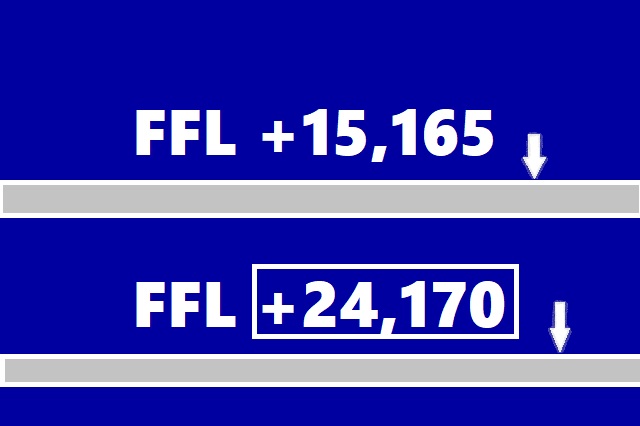Finished floor level

|
Contents |
[edit] What is the finished floor level?
Finished floor level (FFL) refers to the uppermost surface of a floor once construction has been completed but before any finishes have been applied. So, in concrete construction it may be the uppermost surface of a screeded finish, or in timber construction, FFL will denote the top level of floorboards, chipboard or ply decking.
Finished floor level does not take into account any applied finishes as these may be added by owners, occupiers or tenants, will vary in thickness, e.g a thick shag-pile carpet has different thickness to a laminated floor, and may be replaced.
[edit] How is finished floor level expressed?
Floor levels and other vertical dimensions are usually expressed in metres to three decimal places, e.g FFL 16,550. On construction drawings (plans, sections and elevations), finished floor level may be abbreviated ‘FFL 27,000’, the figure suffixed denoting the level in metres above a defined datum level (usually outside ground level or ground floor level). The floor above may be FFL 31,000 and the floor below FFL 23,000.
On some large projects, the job datum may be related to the Ordnance datum - the height of mean sea-level, taken from a reference point at Newlyn in Cornwall. Where there is the possibility of a minus datum figure, the minus sign may be misread or cause confusion if included in FFL data. In these circumstances, a temporary bench mark (TBM) may be introduced to ensure all other levels are positive.
To differentiate between existing and intended (to be constructed) levels, the latter will usually have a rectangle around the numbers. In addition, the numbers may be beside or above an arrow that indicates the finished floor level. On a plan, the exact position where the figure applies is usually indicated by an ‘x’.
[edit] What are the benefits of measuring finished floor levels?
As each floor will have a different level, the FFL figures will have been produced by a measured survey and serve to confirm that:
- The floor levels are correct and have been constructed according to plan.
- Subtracting one floor level from say, the one above can give the FFL-to-FFL storey height.
- They give an indication of the levels relative to ground level, adjacent buildings or other buildings on the site. This is particularly useful when physical links, ramps or walkways must be constructed between buildings.
- FFL figures can be transposed onto elevations to indicate relative floor levels and their relation to the facade.
[edit] Related articles on Designing Buildings
Featured articles and news
The UK's Modern Industrial Strategy: A 10 year plan
Previous consultation criticism, current key elements and general support with some persisting reservations.
Building Safety Regulator reforms
New roles, new staff and a new fast track service pave the way for a single construction regulator.
Architectural Technologist CPDs and Communications
CIAT CPD… and how you can do it!
Cooling centres and cool spaces
Managing extreme heat in cities by directing the public to places for heat stress relief and water sources.
Winter gardens: A brief history and warm variations
Extending the season with glass in different forms and terms.
Restoring Great Yarmouth's Winter Gardens
Transforming one of the least sustainable constructions imaginable.
Construction Skills Mission Board launch sector drive
Newly formed government and industry collaboration set strategy for recruiting an additional 100,000 construction workers a year.
New Architects Code comes into effect in September 2025
ARB Architects Code of Conduct and Practice available with ongoing consultation regarding guidance.
Welsh Skills Body (Medr) launches ambitious plan
The new skills body brings together funding and regulation of tertiary education and research for the devolved nation.
Paul Gandy FCIOB announced as next CIOB President
Former Tilbury Douglas CEO takes helm.
UK Infrastructure: A 10 Year Strategy. In brief with reactions
With the National Infrastructure and Service Transformation Authority (NISTA).
Ebenezer Howard: inventor of the garden city. Book review.
The Grenfell Tower fire, eight years on
A time to pause and reflect as Dubai tower block fire reported just before anniversary.
Airtightness Topic Guide BSRIA TG 27/2025
Explaining the basics of airtightness, what it is, why it's important, when it's required and how it's carried out.
Construction contract awards hit lowest point of 2025
Plummeting for second consecutive month, intensifying concerns for housing and infrastructure goals.
Understanding Mental Health in the Built Environment 2025
Examining the state of mental health in construction, shedding light on levels of stress, anxiety and depression.






















Comments
[edit] To make a comment about this article, click 'Add a comment' above. Separate your comments from any existing comments by inserting a horizontal line.
"So you could potentially end up with a variety of screed levels across the same floor due to varying finish build up? i.e. marble/ carpet/ timber etc. Where's common sense when you need it."
In response to above ^
It is very rare that finishes are known when you begin to design a building (hence this being the sensible working definition for FFL).
Adjustments for things like an unusually thick wearing finish would typically see the screed in the localised area adjusted. This adjustment would then be denoted on applicable plans/section as a +/- from the building FFL for that level.
The minimal difference between carpet/tile etc. is lost in threshold strips.
Hope that makes sense.